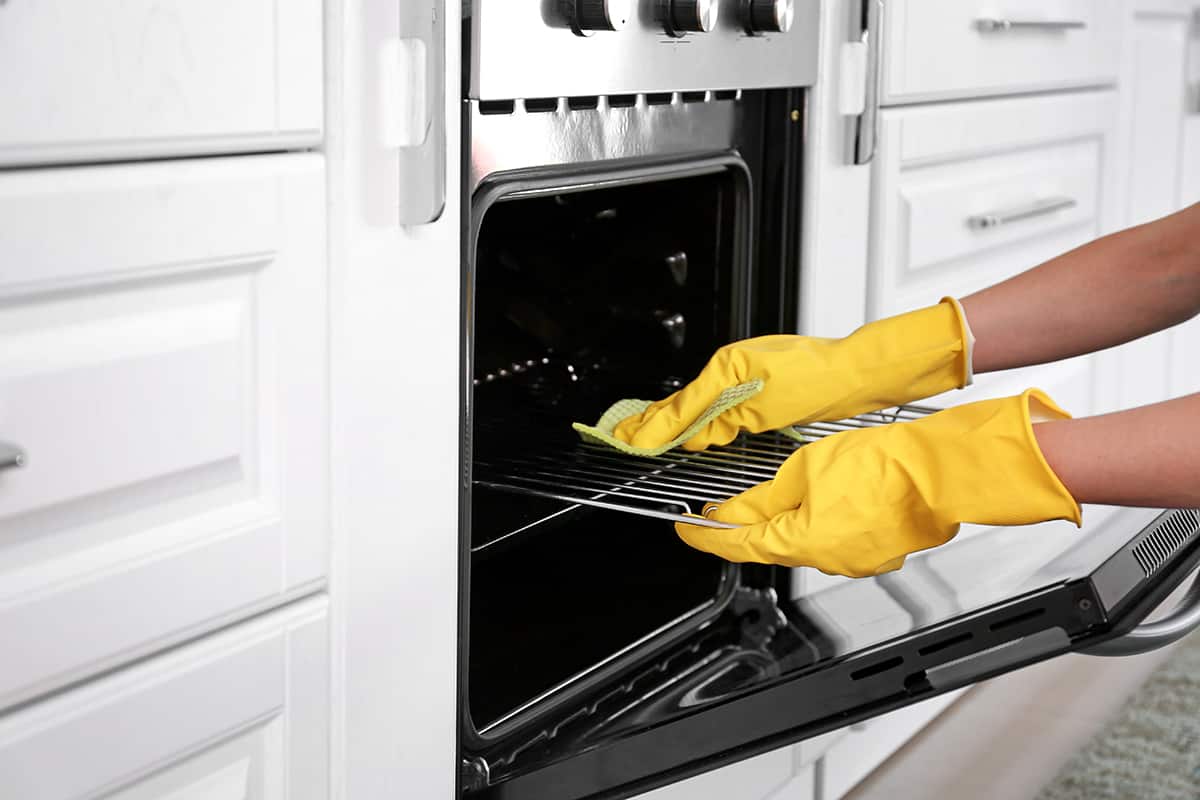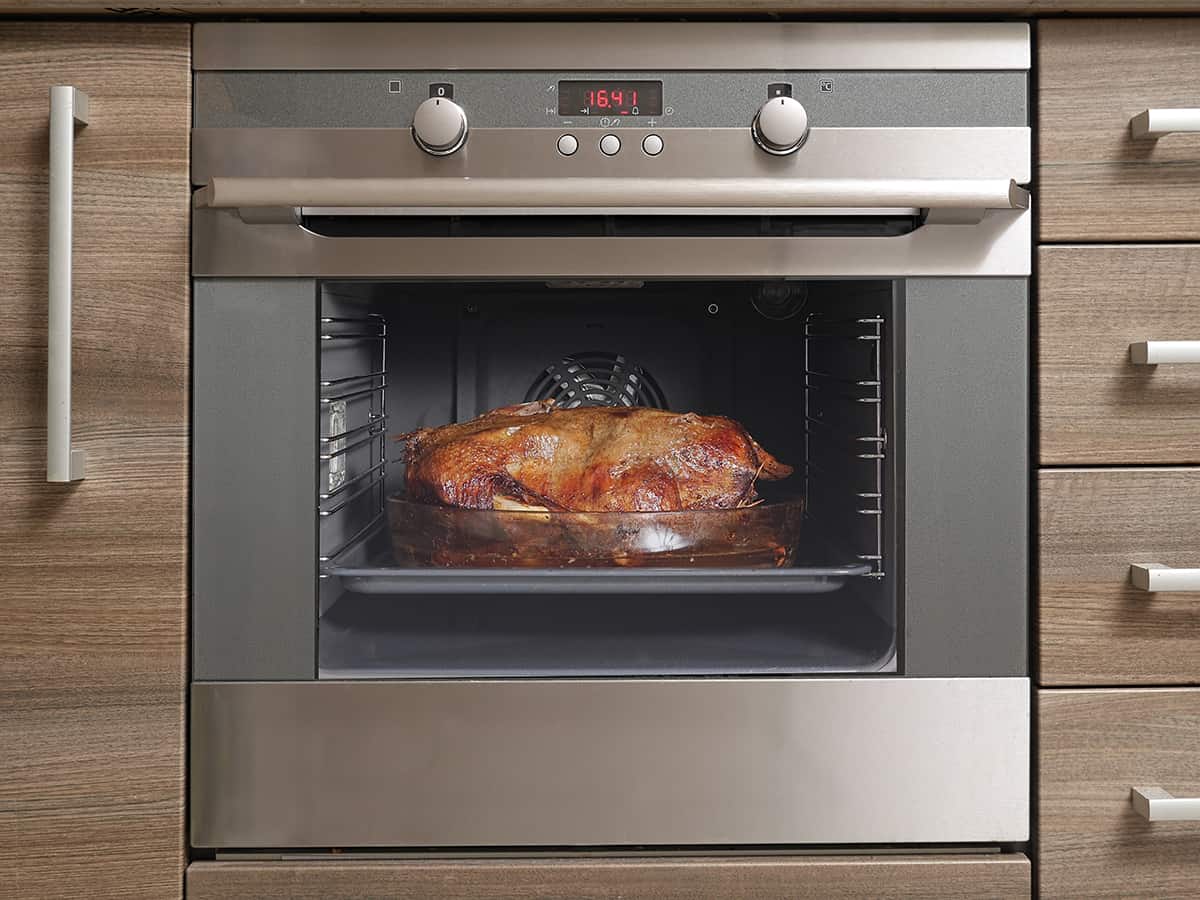So, you’ve just finished cleaning your oven, and all of that labor has made you quite the hungry-hungry hippo. But is it safe to use your oven immediately after cleaning it, or should you wait a bit?
If you cleaned your oven using common household cleaning agents (vinegar, baking soda) or via the self-cleaning feature, you can begin using the oven immediately. However, if you used a commercial cleaner, you need to turn your oven on to 300°F for 15 to 30 minutes to burn the trace amounts of chemicals.
For the remainder of this brief guide, I’ll explain the differences between the different oven cleaning methods, how long you need to wait based on which cleaning technique you used, and what can happen if you don’t burn off the chemical cleaner from your oven.
Oven Cleaning Methods
The worst thing you can do to your oven is not clean it. Immediately after using your oven, you should let it come down to room temperature before giving the inside a thorough wipe-down. That way, all of the greasy and solid food soils won’t set it and become close to impossible to remove in the future.
Of course, all of this is easier said than done. In fact, it’s completely fine to continue using a somewhat dirty oven, as long as you remove the soil before they build up to become too overwhelming.
There are three common methods of cleaning an oven—namely, using household cleaning agents, using the self-cleaning cycle, and using commercial cleaners.
Using household cleaning agents
You’ve probably read somewhere that vinegar and baking soda are excellent household cleaning ingredients, and that’s true! Both of these common ingredients can be used to remove limescale buildup, eliminate odors, and loosen caked-on debris from metallic or fabric surfaces.
To use vinegar to clean an oven, combine 1:4 parts of vinegar and water, stir the concoction, then spray it on the inside of your oven. Let it sit for 1 to 2 minutes before using a clean microfiber cloth to gently wipe the oven’s interior. Continue doing this until all of the soil in your oven is gone.
With baking soda, you’ll have a much easier time removing caked-on debris inside your oven. Sprinkle 1 or 2 cups of baking soda into your oven and spray it with a 1:3 mix of vinegar and water. Let the chemicals react for about 15 minutes before using a clean cloth to wipe down the oven.
Using the self-cleaning cycle
Many modern ovens come with a preprogrammed self-cleaning feature that harnesses the power of heat to burn food soils to crisp. Self-cleaning ovens normally reach temperatures of around 800°F, which is several hundred degrees higher than most broiling settings.
This process usually takes between 1 and 2 hours, depending on the model. The oven door will remain locked during the cycle and only unlock after 30 to 60 minutes of cooling down. When the cycle is complete, simply use a slightly moistened rag to pick up the ashy residue from inside the oven.
Using commercial cleaners
You can use commercial cleaners, such as the Weiman Oven & Grill Cleaner, to quickly and effectively loosen and remove greasy and solid remnants in your oven. They are made up of a bunch of chemicals, including fragrances, to make cleaning ovens way easier. Just follow the instructions on the package to see where to spray the cleaner, how long you need to let it sit, and how to wipe it away.
How Long After Cleaning an Oven Can You Cook?
The answer to this question is it depends on which cleaning method you employed.
- Using household cleaning agents—You can use the oven immediately after cleaning.
- Using the self-cleaning cycle—You can use the oven immediately after cleaning.
- Using commercial cleaners—You can use the oven 15 to 30 minutes after cleaning.
Now, you’re probably wondering why commercial cleaners require at least a 15-minute waiting period. The answer is quite simple: no matter how well you wipe away the cleaner, there will be trace amounts clinging to the inside of your oven.
Commercial cleaners come with a bung of hard-to-pronounce chemicals, including butoxydiglycol and monoethanolamine. These chemicals may not be harmful to you in trace quantities, but I wouldn’t risk it.
So, if you’ve used a conventional oven cleaner, you should find a way to get rid of the leftover chemicals. I’ll explain how down below.
How to Remove Chemicals from Your Oven

After cleaning the oven with a commercial cleaner, here’s what you need to do:
- Wipe down the oven’s interior surface with a moistened cloth. Repeat this step at least 2 times to remove as much of the chemicals from the cleaner as possible.
- Preheat your oven to at least 300°F (15 to 20 minutes).
- Let your oven continue to cook at the set temperature for 15 to 30 minutes (the longer, the better).
- Shut off the oven and let it come down to room temperature.
- Moisten a clean rag in water and use it to wipe down the interior of the cool oven. Repeat this step at least twice.
After that, your oven should be completely rid (or close to it) of chemical traces. Feel free to use your oven for whatever recipe you have in mind!
Please note that burning the chemicals can turn them into toxic vapor. That’s why you need to make sure that you’ve removed as much of the cleaner as possible from your oven before turning it on. So, I highly advise that you stick to vinegar and/or baking soda—not just to make your oven safe to use but also safe to use immediately after cleaning!
Can You Use a Cleaner on a Self-Cleaning Oven?
You should not use chemical cleaners at the same time as you use the self-cleaning function in your oven.
There’s no telling how the chemicals in the conventional clean will react to temperatures exceeding 800°F. They could turn to a fine vapor that permeates the air in your kitchen to become a breathing hazard to you and everyone else.
If you want to use a commercial cleaner in an oven, only use it when you are not going to run a self-cleaning cycle. That way, you reduce the risk of superheating the chemicals into a possibly toxic vapor.
What Is a Steam-Cleaning Oven?
Another lesser-known method of cleaning an oven is with the use of steam. In fact, some ovens are marketed as having built-in steam-cleaning capabilities. But how exactly does this work?
Basically, you put water into an oven and turn it up to its highest setting. The water will turn to vapor, which loosens the caked-on debris, allowing you to wipe it away with a single swipe of a rag or cloth. You can enhance the cleaning properties of steam by mixing vinegar into the water (1:4 mix).
If you don’t have an oven with a steam-cleaning function, there are portable steam cleaners, such as the Black + Decker HSMC1361SGP, , which come with a wide range of accessories. Simply fill the tank with water, let it come to a boil, and aim the nozzle into your oven to loosen grime and solid food soils.
The great part about steam-cleaning is that you don’t have to wait to use the oven immediately after you’re done cleaning it. Since steam is simply water vapor with trace amounts of vinegar, it will not leave a chemical-filled residue on the oven’s inner walls. Just use a clean cloth to wipe down the inside of the oven after you’ve steam-cleaned it.






